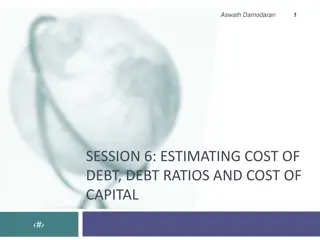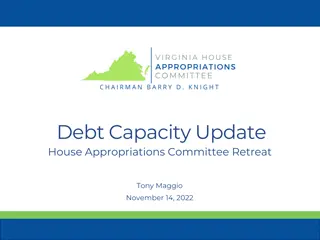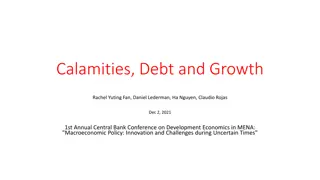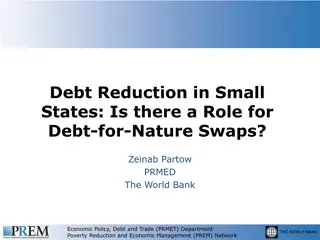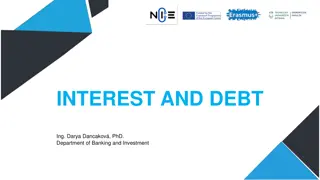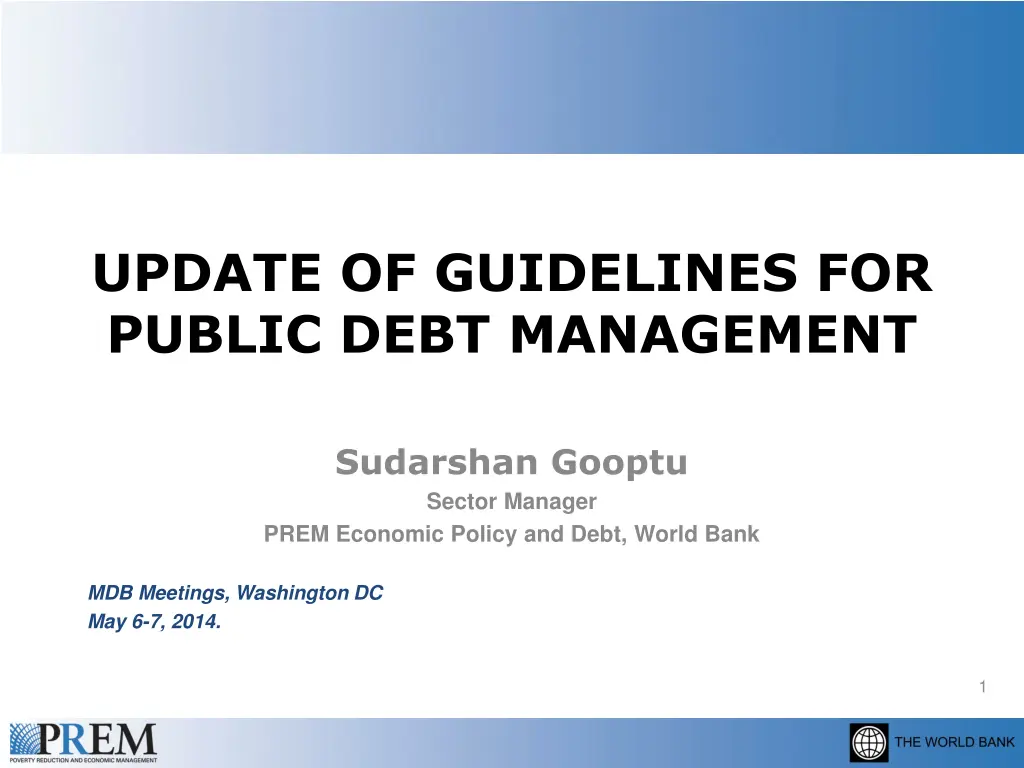
Key Areas of Public Debt Management Guidelines Update
A comprehensive overview of the update process for public debt management guidelines presented at the World Bank MDB Meetings in 2014. The need for updating, key revision areas, and the importance of effectively managing government debt are highlighted. Explore the evolution of voluntary principles to enhance debt management practices amid changing financial landscapes.
Download Presentation

Please find below an Image/Link to download the presentation.
The content on the website is provided AS IS for your information and personal use only. It may not be sold, licensed, or shared on other websites without obtaining consent from the author. If you encounter any issues during the download, it is possible that the publisher has removed the file from their server.
You are allowed to download the files provided on this website for personal or commercial use, subject to the condition that they are used lawfully. All files are the property of their respective owners.
The content on the website is provided AS IS for your information and personal use only. It may not be sold, licensed, or shared on other websites without obtaining consent from the author.
E N D
Presentation Transcript
UPDATE OF GUIDELINES FOR PUBLIC DEBT MANAGEMENT Sudarshan Gooptu Sector Manager PREM Economic Policy and Debt, World Bank MDB Meetings, Washington DC May 6-7, 2014. 1
Presentation Outline I. Background Public Debt Management Guidelines Need for Updating Process of Updating II. Key Areas of revision 2
Public Debt Management Public debt management is the process of establishing and executing a strategy for managing the government s debt in order to raise the required amount of funding at the lowest possible cost over the medium to long run, consistent with a prudent degree of risk. Should also meet other DM goals such as developing and maintaining an efficient market for government securities 3
Guidelines (1) WB-IMF Guidelines for Public Debt Management published in 2001, amended in 2003 In February 2013, G-20 Finance Ministers and Central Bank Governors requested WB-IMF to consider revising Guidelines given changes in macro financial environment and debt management practices A working group of debt managers from WB-IMF members formed to take stock of existing Guidelines and identify areas of widespread agreement for needed updates to ensure relevance and topical need The debt managers insights enabled reiteration of broadly applicable principles, institutional and operational foundations, with relevance for members from wide range of institutional structures and at different stages of development 4
Guidelines (2) Guidelines are a set of voluntary principles to assist debt managers in improving their debt management practices and reducing financial vulnerability Implementation of Guidelines is voluntary, Guidelines incorporate a range of good practices rather than adopt a prescriptive approach Scope of the review was limited to public debt management Focus on identifying and addressing related gaps that have emerged due to financial sector and macroeconomic changes 5
Need for Updating Changes in financial sector regulation and macroeconomic policy developments affected financial landscape in which debt managers operate Greater volume of public debt issuance, higher cross border capital flows, and more volatility in investor risk appetite Debt portfolios altered in terms of size and composition Portfolio changes along with use of collective action clauses (CACs ) in efficient resolution of debt restructurings and growing importance of managing contingent liabilities highlighted core debt management practices These practices that relate to both institutional and portfolio risks needed to be updated in Guidelines 6
Six key areas of revision 1.Debt management objectives and coordination; 2. Transparency and accountability; 3. Institutional framework; 4. Debt management strategy; 5. Risk management framework; and 6. Development and maintenance of an efficient market for government securities. 7
Debt Management Objectives and Coordination Debt Management Objectives remain same: To raise required funding at lowest possible cost within a given risk tolerance Revisions include useful coordination between fiscal policy and debt management Role of debt manager in providing pertinent information for DSA is recognized Debt managers to advise fiscal authorities on amount of new debt that can realistically be absorbed by market, especially during periods of crisis Information exchange and solicitation of debt manager s views on consequences of financial sector regulations on debt markets, given recent developments in financial sector regulations 8
Transparency and Accountability Greater guidance on enhancing communication with investors, especially during periods of crisis Pertinent information on debt composition and risk indicators be periodically provided to minimize uncertainty Legal documentation relevant to debt management be easily accessible External audits of IT systems and risk control procedures be periodically conducted 9
Institutional Framework Further guidance on collective action clauses (CACs) was considered necessary Greater use of CACs in bond contracts considered desirable for efficient restructurings Amendment on CACs, are incorporated into main text of the updated Guidelines This is in line with the recent developments in this area 10
Debt Management Strategy More details on risk mitigation strategies, particularly on liquidity and refinancing risk, and contingency plans, including the building of cash buffers Practical limitations of applying the asset- liability management (ALM) framework Importance of developing domestic debt market as a strategy to mitigate exchange rate risk included 11
Risk Management Framework Greater emphasis to stress testing of the debt portfolio Use of derivatives in managing risk is given greater prominence and the need to manage the resulting credit risk is noted Debt managers need to take account of risks arising from contingent liabilities, including PPPs 12
Development and Maintenance of an Efficient Market for Government Securities Guidance on appropriate DM policies to enhance liquidity of domestic bond market Approaches to promptly identify and address impediments to development of domestic government bond markets Importance of retaining some flexibility in the issuance program is noted, as borrowing plans may need to change during times of severe market turbulence when investors face severe dislocations 13
Next Steps Issue Press Release Disseminate revised Guidelines Inform G-20 Publish as Bank-Fund publication Issue IMF Survey Include in DMF Newsletter Please visit http://go.worldbank.org/48MIDC8BH0 http://www.imf.org/external/pp/longres.aspx?id=4855 14







